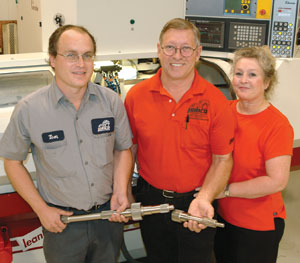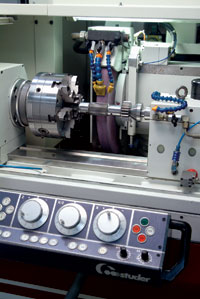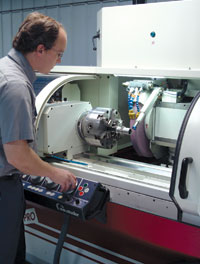February 2008 Edition
grinding
Tranny maker to racing pros traffics in near perfect world
 Son Tom and founders Jerry and Cheryl Hemmingson keep the operation humming. Jerico was founded 27 years ago.
Son Tom and founders Jerry and Cheryl Hemmingson keep the operation humming. Jerico was founded 27 years ago.
When it comes to Jerico transmissions, winning over and retaining race car drivers such as Tony Stewart, Denny Hamlin, and Terry and Bobby LaBonte isn't a matter of competing on price.
To be sure, a Jerico transmission has to be price-sensitive. More important, though, it must perform flawlessly and with absolute repeatability under demanding conditions.
Jerico exercises tight process and quality control and employs state-of-the art machining and grinding technology. Each Jerico transmission is meticulously produced and assembled entirely by hand.
Jerico employs highly skilled technicians in a 50,000-sq-ft facility in Concord, NC. Jerico's technology line-up includes seven Okuma Howa CNC lathes, six Matsura CNC mills, a collection of gear machines (a five-axis CNC Mitsubishi, some Pfauters, Fellows, and Clevelands), a stable of automated manual universal grinders (OD and ID), and a Studer S30 CNC universal cylindrical grinder from United Grinding Technologies, Miamisburg, OH, which has a B-axis swiveling turret wheelhead for external, internal, and face grinding in a single setup.
"The only things we don't do internally are casting and heat treating," Jerico founder Jerry Hemmingson says. "We run very hard material — 60Rc high-nickel steel. We do 52100 bearing quality on some shafts, but the majority is carbonized 9310, 4820 — very tough alloys — and all our gears and shafts are cryogenically treated."
Grinding tolerances, Hemmingson says, run ±0.0001", maximum, and are generally tighter than that.
"Actually, we don't tolerance our parts," he says. "We go straight for the specific number, the exact tolerance. In this business, plus or minus just isn't close enough. And while there's no such thing as perfect in an imperfect world, that's exactly what we strive for."
Critical technology
This kind of emphasis on precision and quality is reflected in Hemmingson's choice of technology. The Studer S30, for example, was by no means the least expensive grinding solution option However, when he began to upgrade his grinding operation, Hemmingson sought quality and reliability first and foremost.
"I looked at some lower-cost import machines and just didn't think they'd hold up," Hemmingson says. "It would have been less expensive to go with a Taiwanese or Chinese machine — I've had some experience with these in manual machines — but the Studer quality was so much superior, I couldn't see going any other way. It's like with our choice of mills; they're some of the best made, and there are a lot of others out there — same size machine — at half the price. But, why buy down just to save money? What good is a machine if you can't count on it to deliver, at the quality level you need? We've had the Studer for about six years, and the only thing we've had to do is replace a few belts."
Top trannys
The trannys have been used by more winning racers than any other. Add to that more than half of the other Winston Cup teams and two-thirds of Cup winners. The same can be said of winners in the Busch Series and Craftsman Truck Series, IROC, the Busch Grand Nationals, ARCA, SCCA, all classes of NHRA Stock Eliminator and IHRA drag racing, off-road racing, hill climbing, Pikes Peak Stock Car and Super Truck events, the Bonneville Salt Flats speed trials, the 24 Hours at Daytona, the 12 Hours at Sebring — not to mention transmissions for high-performance power boat racing, motorcycle racing, and all types of road course and short-track weekend racing.
In other words, outside of open-wheel CART and Indy-type cars, the world of racing is Jerico territory.
Hemmingson grew up around cars. As a farm kid in Minnesota, he acquired his first one, a 1938 Ford, when he was nine years old. He couldn't drive, of course, and the Ford didn't run, neither of which really mattered much. What did matter was taking the car apart and putting it back together — again and again.
"My great-great-grandfather," Hemmingson recalls, "designed and built cars back at the turn of the last century — engines, patterns, everything, the whole automobile. The car was a Holland, named after him. There are a few of them left in museums in northern Minnesota. So, I guess you could say building and working on cars came naturally."
Which eventually led to Jerico Performance and Jerico Racing Transmissions.
A closer look
Hemmingson says that the main shaft in a Jerico transmission typically has seven journals. In the past, they'd set up two or three manual machines to grind each individual journal sequentially. To maintain size and tolerance, the wheel had to be dressed after only a few shafts.
 A Studer S30 CNC universal cylindrical grinder has a B-axis swiveling turret wheelhead for external, internal and face grinding in a single setup.
A Studer S30 CNC universal cylindrical grinder has a B-axis swiveling turret wheelhead for external, internal and face grinding in a single setup.
"It's very hard to come to size on a manual machine," he says, "so we'd do all the rough grinding of the journals, one at a time on each machine, and then we'd come back and finish-grind the last couple of thousandths. This is the only way we could maintain tolerance with any real repeatability."
However, this approach required a great deal of handling and operator intervention. Generally, they'd run 100 shafts at a time of each of several different kinds of main shaft, but the time consumed in just handling the shafts — setup, loading and unloading — was proving unacceptable.
"With the S30," Hemmingson says, "we can put a shaft in and program the machine in such a way that it automatically rough-grinds all the journals, dresses the wheel, then comes back and finishes the journals. All in one setup, in 10 to 15 minutes, the whole shaft, one handling, and it's perfect every time. We're saving an average of 75 percent in time per shaft. And the S30 has replaced four of the automatic manual OD and ID machines."
The S30 has also significantly cut down on rework and scrap due to dramatically reduced operator involvement in the grinding process. With a manual machine, Hemmingson notes, one has to set end stops, and invariably from time to time one crashes a shoulder and ruins a part, which would be very difficult to do — if not impossible — on the S30.
Hemmingson notes that changeover on OD parts is very quick — perhaps 10 to 15 minutes to change all grinding parameters. He attributes this in large part to the S30's Quick Set touch probe and length positioning capability. Changing over from OD work to ID work, however, takes a bit longer.
"Take cluster shafts," Hemmingson says. "We grind the OD, which is a pretty simple operation, and then we switch over the machine to do the ID work using a big six-jaw chuck. We chuck on the ground OD of the spline, and grind the ID of the bores for the bearings. Changeover can take 90 minutes, but once the machine's setup, it runs through the parts very, very quickly. When we do this kind of OD/ID work, we save it up and then gang it through the Studer."
Hemmingson notes that the length positioning features allows "eyeballing" the part in the chuck because as the probe "touches off," the machine knows where zero is all the time and thus the control is constantly aware of the part length. With length positioning, the types of crashes and resulting scrap associated with manual machines are eliminated.
"I program the S30 off-line in my office," Hemmingson says. "But all the necessary programming can be done at the machine as well. Studer Pictogramming makes it very easy. You can edit in Pictogramming or edit in G code. And since many of our shafts are very similar, we can just switch out a few parameters on the touch screen, and we're ready to run a different shaft."
Jerico transmission main shafts are typically 22" to 24" long. A typical grinding routine might start by grinding the smallest shaft diameter, about 0.800", which is followed by a couple of diameters in the 1.375" range, followed by a step up to a diameter of 1.600". On one shaft type a 3" hub appears next, followed by stepping down — to one diameter at 1.600", followed by a couple of diameters again in the 1.375" range, followed by the 0.800" smallest diameter.
"The S30 automatically adjusts the workpiece speed and the feedrate," Hemmingson says, "and with long shafts like these, we have a Studer spring-loaded steady rest that runs on the part and eliminates potential chatter from the process."
No gaging required
Hemmingson says they have a Marposs gaging package for the S30. The "U" of the horseshoe-shaped gage automatically feeds in, collars the OD, takes shaft diameter dimensions and then automatically feeds back out. Data are automatically relayed to the Fanuc 21i control and can then be used to establish trend analysis, to detect wheel wear, for example, that might lead to an out-of-tolerance situation. Hemmingson, however, says at Jerico they simply don't use the gaging system.
'With the S30,' Hemmingson says, 'we can put a shaft in and program the machine in such a way that it automatically rough-grinds all the journals, dresses the wheel, then comes back and finishes the journals. All in one setup, in 10 to 15 minutes, the whole shaft, one handling, and it's perfect every time. We're saving an average of 75 percent in time per shaft.'
"We run the S30 continuously through eight-hour shifts," he says, "and once the machine is up to temperature — generally a cycle or two — it stays right on size, hour after hour, all day long. So, why use gaging? If the machine is this accurate, why add a process that doesn't add value — might, in fact, interfere with the process should something go wrong with it?"
Hemmingson says that gaging really doesn't have a role in his grinding strategy. Where he does see it playing a significant role is in production grinding shops. Here, because of the volumes and margins, people have to really push their machines, grinding very fast and at very heavy feed rates. Without some type of gaging in this environment to tell an operator when to slow down and take a lighter feed, the results, invariably, are "part casualties or part fatalities."
"We don't push any of our machines like a production shop has to," Hemmingson says. "We'd rather have a better part that might take a little longer to grind; we're in the business of grinding quality parts, not quantities of parts. We may do 2,000 main shafts this year — which for us is a lot. And if we're building quality into the process, and we're using top quality machines and people, and we're not pushing the technology to the limit, we don't need gaging. It's the strategy we use. And it works pretty well. We've never had a major crash on any machine yet, and we've been building Jerico racing transmissions for more than 27 years."
Being unique
"Until we began building our transmissions for NASCAR in the 1970s," Hemmingson says, "the teams pretty much used standard, synchronized three- and four-speed transmissions supplied by the auto companies. And what we learned very early is that if you get it from stock, off-the-shelf, it won't last in racing. If you can buy it, you'll break it. If it works on the street, it's not ready for the track. You have to make racing transmissions — design the shafts and the gears, make the shafts and the gears — for the high stresses and torque of racing. And just about every type of racing requires a different type of transmission."
 Tom Hemmingson checks the operation of the Studer S30.
Tom Hemmingson checks the operation of the Studer S30.
Hemmingson notes, for example, that the transmissions he builds for drag racing are entirely different animals from the ones he builds for Winston Cup or the Busch Series. The former, he says, are truly clutchless transmissions, while the latter are designed to be shifted with a clutch — whether they are or not.
"It all depends on the driver," he says. "Some drivers clutch when they up-shift, some when they down-shift, some neither, some both. Some drivers are actually better shifting without a clutch at all. So we have to make a transmission that addresses all the preferences."
Hemmingson says that one of the reasons that Jerico transmissions have gained such favor is precisely because their ease of shifting — and their durability. Both start with a unique gear design. Unlike others, Jerico transmissions utilize a non-standard tooth design and straight cut gears as opposed to conventional helical gears. The result is that the energy is channeled into rotating the gears in a straight fashion rather than pushing in an angular helical fashion, side-to-side.
"Drivers like the transmission because it's easy to shift," Hemmingson says. "The transmission engages on the face of the gear tooth, which is more like a motorcycle transmission than a conventional synchronized transmission. This makes for a very fast, smooth shift."
Success, growth
Hemmingson notes that today there are a fair number of competitors copying his transmission designs and popping up in a growing range of racing venues. However, as with any front-leading product or technology, Jerico transmissions continue to evolve and change to meet the new and constantly changing need of the sport.
"You know, if you're outside this business looking in," he says, "it probably looks like a very small number of customers or clients. Often, it seems that way to us. But the number of customers, like the numbers of fans and enthusiasts of motorsports everywhere, continues to grow. We now sell all over the world. And there's racing going on in places you'd never think of when you think of racing — South Africa, Sweden, Finland, the Netherlands, England. This may reflect a wide variety of types of racing, but it's still racing, and it's still engineering and mechanics, and the mechanics have to work. To be successful and stay ahead, you have to invest in the best technology you can find and the best people to run it." United Grinding Technologies
What do you think?
Will the information in this article increase efficiency or save time, money, or effort? Let us know by e-mail from our website at
www.ToolingandProduction.com or e-mail the editor at
dseeds@nelsonpub.com.